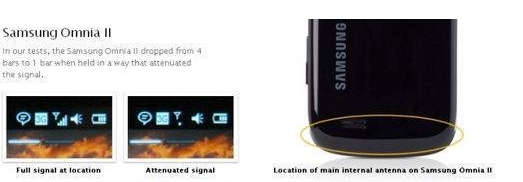苹果公司宣称,iPhone 4的用户报告中所谓“信号衰减”问题,目前市场上的所有智能手机的天线都存在与之类似的问题。对于上述言论,业内四大手机OEM厂商都公开进行了回斥。
Droid X手机制造商摩托罗拉公司、世界顶级无线电话制造商诺基亚公司,以及黑莓设备制造商RIM公司分别发表声明,反对由苹果公司董事长兼首席执行官斯蒂芬·乔布斯(Steve Jobs)宣称所有的智能手机都有信号衰减的天线问题或者倾向。
苹果公司的最新无线产品iPhone4上市以来,有一些客户抱怨通话时发生断线的情况,并表示这是由于该手机的天线设计存在问题。对此,7月16日,即上周五乔布斯为其进行了辩护并提出了意见。
乔布斯称:天线设计是整个行业面对的挑战。
苹果公司表示对于使用不满的用户无条件退货(但必须是在购买后30天之内);而对于仍想保留手机却担心收讯问题的用户,苹果将免费提供用户手机“保护套”
“苹果的目的是要将RIM拉进苹果自制的旋涡里,这一点是不可接受的。” RIM的联合首席执行官Mike Lazarids 和Jim Balsillie在声明中表示,“苹果声称RIM的产品存在收讯问题是有预谋的,它们故意歪曲大众对于天线设计的认识,试图以此来混淆公众的视听,并转移苹果现在的困难局面。”
RIM两位CEO进一步指出黑莓不需要使用橡胶盖,来防止信号衰减。而对于苹果,他们表示:“显然地,作出一些新的设计并对此负责,采用它们解决问题,才是苹果明智的行动,而不是试图拉RIM以及更多厂商来趟这次的浑水。”
摩托罗拉公司联合首席执行官Sanjay Jha发表声明说:“声称所有的手机表现都一样,这样的解释显然缺乏诚意。” Sanjay Jha也是负责该公司的手机业务。
摩托罗拉表示,在测试其最新的移动设备Droix X的性能时,结果表明“在消费者手持状态下,该款设备的性能比iPhone 4更好。” Droix X现在正由Verizon公司出售。
{pagination}
诺基亚,芬兰的公司,销售超过全球范围内使用的所有手机的三分之一。回应该事件时,诺基亚的声明更多了一份对于苹果公司做法的嘲讽。
诺基亚在声明中称:天线设计是一项很复杂的工程,但10多年来,这一直是诺基亚的一项核心竞争力。在内置天线设计上,诺基亚是先锋,早在1998年推出的Nokia 8810中就已经采用了内置天线。
在用户使用手机的方式上,如打电话时握手机的方式,听音乐时的方式,以及浏览互联网时的方式等,诺基亚都投入了大量测试时间。当天线的物理设 计和天线性能发生冲突时,我们更主要性能,而不是设计。
在手握住手机时,天线的性能确实会受到影响。因此,在设计天线时,我们要确保天线的性能,无论用左手还是右手握住手机。天线放在顶部还是底部, 还有材料等,都是诺基亚考虑的问题。
另一家被乔布斯在新闻发布会上点名批评的手机厂商三星也在日前发表了官方声明。针对乔布斯在信号问题的视频演示中提及的是Omnia 2手机,三星就这一具体机型反驳了苹果的说法。
三星发言人Korea Herald指出:“Omnia天线设计在手机的底部,而iPhone 4的设计却是将天线放置在设备的左下角。因此,我们的设计保持了使用者的手与天线之间的距离。在手机上市之前,我们对手机进行了全放位的测试,收讯问题到目前为止还没有出现,在将来也不可能出现。”

三星在声明中强调:“基于多年设计高质量手机的经验,三星手机采用一种能够优化任何类型手持电话信号接收质量的内置天线设计技术。”
现在几乎整个业界的矛头都指向苹果,大多数手机厂商在把苹果拉下马这点上似乎已经达成共识……
点击进入第三页:(参考原文Motorola, Nokia, RIM, reject Apple antenna claim, by Bolaji Ojo)
翻译/增值:Ana Hu
《电子工程专辑》网站版权所有,谢绝转载
相关阅读:
{pagination}
Motorola, Nokia, RIM, reject Apple antenna claim
by Bolaji Ojo
Apple Inc.'s contention that all smartphones in the market have antenna and “dropped call” problems similar to the ones reported by iPhone 4 users has been rejected by three of the leading mobile phone handset OEMs in the industry.
In separate statements, Motorola Inc., maker of the Droid X handset, Nokia Corp., the world's top manufacturer of wireless phones, and Research In Motion Inc., the maker of the Blackberry device, objected to statements by Apple chairman and CEO Steve Jobs indicating all smartphones have a tendency to drop ongoing calls.
Jobs made the observation while offering a spirited defense Friday, July 16, to concerns about the performance of Apple's latest wireless handset, the iPhone 4. Some customers had complained calls were being cut off due to problems associated with the phone's design.
Antenna design, according to Jobs is “a challenge for the entire industry.”
Apple has offered to reimburse dissatisfied users and is providing free cases referred to as “bumpers” for iPhone 4 buyers who wish to keep their phones but are concerned about the likelihood of dropped calls.
“Apple's attempt to draw RIM into Apple's self-made debacle is unacceptable,” RIM's co-CEOs Mike Lazarids and Jim Balsillie, said in a statement. “Apple's claims about RIM products appear to be deliberate attempts to distort the public's understanding of an antenna design issue and to deflect attention from Apple's difficult situation.”
The RIM co-CEOs further stated the Blackberry does not require the use of a rubber cover to help prevent signal degradation. Apple, they said, “ clearly made certain design decisions and it should take responsibility for these decisions rather than trying to draw RIM and others into a situation that relates specifically to Apple.”
In its own statement issued by co-CEO Sanjay Jha who also heads the company's mobile handset business, Motorola said: “it is disingenuous to suggest that all phones perform equally.”
The company said tests it performed on its latest mobile device, the Droix X now being sold by Verizon Inc., indicate the equipment “performs much better than iPhone 4 when held by consumers.”
Nokia, the Espoo, Finland-based company that sells more than one-third of all mobile handset used worldwide, confirmed Apple's claim that antenna design is quite “complex.” Nokia further validated opinions in the market that the “antenna performance of a mobile device/phone may be affected with a tight grip.”
The company said it had as a result ensured all Nokia phones were designed “to ensure acceptable performance in all real life cases, for example when the phone is held in either hand,” a jibe at Apple's explanation that the iPhone 4's performance could be poorer than expected when held in a certain way by users.
“As you would expect from a company focused on connecting people, we prioritize antenna performance over physical design if they are ever in conflict,” Nokia said.